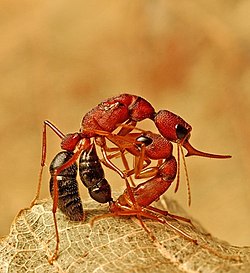跳鐮猛蟻
| 跳鐮猛蟻 | |
|---|---|

| |
| 擬工蟻(上面)和工蟻(下面)打架 | |
| 科學分類 | |
| 界: | 動物界 Animalia |
| 門: | 節肢動物門 Arthropoda |
| 綱: | 昆蟲綱 Insecta |
| 目: | 膜翅目 Hymenoptera |
| 科: | 蟻科 Formicidae |
| 屬: | 鐮猛蟻屬 Harpegnathos |
| 種: | 跳鐮猛蟻 H. saltator
|
| 二名法 | |
| Harpegnathos saltator (T. C. Jerdon, 1851)
| |
| 異名 | |
|
Drepanognathus saltator Jerdon, 1851 | |
跳鐮猛蟻(學名:Harpegnathos saltator,英文:Indian jumping ant 或 Jerdon's jumping ant) 又稱舞鐮猛蟻,是一種在印度發現的鐮猛蟻。它們有細長的上顎,能夠跳躍幾英寸遠 [1] 它們是具強烈視力且活躍的捕食者,主要在清晨捕獵。蟻群規模很小,工蟻和蟻后之間的差別很小。
亞種
[編輯]- 跳鐮猛蟻大眼亞種 Harpegnathos saltator cruentatus Smith, 1858[2]
- 跳鐮猛蟻黑腹亞種 Harpegnathos saltator taprobanae Forel, 1909[2]
習性
[編輯]
與其他螞蟻不同,它們通常單獨出現或成小群出現,並且它們的蟻群由很少的個體組成。它們在整個蟻科中也很不尋常,因為擬工蟻和工蟻之間的差異非常小,有些工蟻可以像擬工蟻一樣交配並產下受精卵。[3] 這些工作人員被稱為有性工蟻(gamergates)。蟻群由單個擬工蟻建立,隨著蟻后年齡的增長,會被其他繁殖工蟻所取代。[4] 有性工蟻與來自同巢的雄蟻交配,並且由於是近親繁殖,所以與最初的創始擬工蟻有親緣關係。群落從來不會經歷裂變而形成新的殖民地。

當擬工蟻或已建立的蟻群出現時,工蟻會監管那些試圖產卵,但沒有蟻后地位的新工蟻,從而限制蟻群中繁殖蟻的數量。[5][6] 工蟻使用的報警信息素包括4-甲基-3-庚酮、4-甲基-3-庚醇和異戊酸異戊酯。[7] 與許多種類的螞蟻一樣,該物種能從上顎腺中產生4-甲基-3-庚酮。已發現杜氏腺分泌物包括C15至C25的直鏈烴的複雜混合物,其中成分主要是順-9-二十三碳烯,還有丙酸十四酯和痕量乙酸十四酯和乙酸十二酯等其他次要成分。咽後腺的分泌物和角質層蠟質中均含有常見脂肪酸的甲酯。[6]
它們的跳躍是通過中腿和後腿同步伸展來完成的。最多可以跳2厘米高,10厘米遠。這些跳躍不僅是為了逃跑,也是為了捕捉空中的獵物。[1] 工蟻只在早晨和下午涼爽的時候覓食,中午時分活動較少。[8]
巢穴入口通常是地面上的一個低矮土丘,入口周圍環繞著樹枝和樹葉。蟻巢的入口在傍晚時分被螞蟻關閉,並在白天重新打開。主室的前室有一個漏斗狀的開口,這種結構被認為可以防止主室被洪水淹沒。[9]
一項對基因組和表達基因的研究發現,當工蟻變成蟻后時,延緩衰老的酶(端粒酶和sirtuin去乙醯化酶)的產生會增加,換句話說就是「登基可延長5倍壽命」。[10] 工蟻在進入繁殖期(成為有性工蟻)後,其腦部尺寸也會減小。 [11]
描述
[編輯]
以下是TC Jerdon的原始描述。[13]
| “ | Worker, head long, granulated; jaws with a strong tooth near the base pointing downwards and inwards, and thence gradually tapering to the tip, and finely serrated, 1–6th of an inch long; thorax barely grooved; abdominal pedicle small, low, ovate; abdomen very long; sting large; head and abdomen blackish brown, thorax and legs rufous – Length 3/4 of an inch. I have not seen this remarkable Ant in the Carnatic. I first saw it at Tellicherry, and subsequently in other parts of Malabar. It is also found in the Mysore country as I learn from Mr. Hamilton, a most talented and industrious Amateur Entomologist. I have given it the name of saltator from its power of making most surprising jumps which it does when alarmed or disturbed. It is very pugnacious, and bites, and stings very severely. It makes its nest under ground, generally about the roots of some plant. Its society does not consist of many individuals. It appears to feed on insects, which it often seizes alive. |
” |

以下是CT Bingham的《英屬印度動物群(膜翅目 - 第 2 卷)》中的分類描述:
- 工蟻:頭、胸、柄節鐵紅色,密布粗點,顆粒狀;腹部黑色,有光澤,無顆粒狀,點較細散;上顎、觸角、足黃色;整體覆蓋著短而稀疏的直立淡色毛髮,上顎、頭、觸角、胸、足有微小的細小、絹狀的閃亮柔毛,僅在特定光線下可見。
- 擬工蟻(蟻后):與工蟻相似;單眼的位置很低,幾乎位於頭部前部的中間。
- 雄蟻:上顎短,三角形,較寬,但不細長。頭的長度略大於寬度,眼睛後面和枕骨關節處強烈收縮。前部的凹面比獵鐮猛蟻的更短且更寬。並胸腹節的後面邊緣清晰。第一節腹節梨形延長,與獵鐮猛蟻類似。基底兩節之間無收縮。枕骨後方有一小塊中央隆突。光滑閃亮。後背板、柄及中背板側面的一部分有粗皺紋。胸部其餘部分有一些凹紋或過時的條紋。類似於獵鐮猛蟻的Pilosity。紅棕色,花梗顏色較深。腹部褐色。腿和觸角呈淺色。翅透明,翅脈和柱頭顏色很淺。 (基於福雷爾的描述)
飼養
[編輯](※)以下內容主要面向螞蟻飼養員
野外的群落通常最大只有50-150工蟻,通常在灌木叢下的地面或田野中築巢。該物種不喜歡吃死食,對活食更感興趣。喜歡吃土庫曼蟑螂(Turkmen cockroaches)。和獵鐮猛蟻一樣,該物種適宜石膏平面巢。巢內濕度建議99%;活動區為60-80%。溫度25-28°C。有一點非常重要,需要在巢里放椰子土和沙子做為介質,因為鐮猛蟻的幼蟲結繭是需要介質幫助的,沒有介質將無法成功結繭。[14]
參考
[編輯]- ^ 1.0 1.1 C. Baroni Urbani; G. S. Boyan; A. Blarer; J. Billen; T. M. Musthak Ali. A novel mechanism for jumping in the Indian ant Harpegnathos saltator (Jerdon) (Formicidae, Ponerinae). Experientia. 1994, 50: 63–71. S2CID 42304237. doi:10.1007/BF01992052.C. Baroni Urbani; G. S. Boyan; A. Blarer; J. Billen; T. M. Musthak Ali (1994). "A novel mechanism for jumping in the Indian ant Harpegnathos saltator (Jerdon) (Formicidae, Ponerinae)". Experientia. 50: 63–71. doi:10.1007/BF01992052. S2CID 42304237.
- ^ 2.0 2.1 Bolton, B. Harpegnathos. AntCat. 2015.
- ^ C. Peeters, J. Liebig & B. Hölldobler. Sexual reproduction by both queens and workers in the ponerine ant Harpegnathos saltator. Insectes Sociaux. 2000, 47 (4): 325–332. S2CID 8728206. doi:10.1007/PL00001724.
- ^ J. Liebig; H. J. Poethke. Queen lifespan and colony longevity in the ant Harpegnathos saltator . Ecological Entomology. 2004, 29 (2): 203–207. Bibcode:2004EcoEn..29..203L. S2CID 86412019. doi:10.1111/j.1365-2311.2004.00583.x.
- ^ J. Liebig, C. Peeters & Bert Hölldobler. Worker policing limits the number of reproductives in a ponerine ant (PDF). Proceedings of the Royal Society B: Biological Sciences. 1999, 266 (1431): 1865–1870. PMC 1690207
 . doi:10.1098/rspb.1999.0858.
. doi:10.1098/rspb.1999.0858.
- ^ 6.0 6.1 R. R. do Nascimento; J. Billen; E. D. Morgan. The exocrine secretions of the jumping ant Harpegnathos saltator (PDF). Comparative Biochemistry and Physiology. 1993, 104B: 505–508.
- ^ Blum, M. S.; T. M. Musthak Ali; T. H. Jones; R. R. Snelling. Identification of a chemical releaser of alarm behavior for workers of Harpegnathos saltator Jerd. (Hymenoptera, Formicidae). Memorabilia Zoologica. 1994, 48: 17–22.
- ^ Shivashankar, T.; H. C. Sharathchandra; G. K. Veeresh. Foraging activity and temperature relations in the ponerine ant Harpegnathos saltator Jerdon (Formicidae). Proceedings: Animal Sciences. 1989, 98 (5): 367–372. S2CID 83953661. doi:10.1007/BF03179963.
- ^ Peeters, C.; Hölldobler, B.; Moffett, M.; Musthak Ali, T.M. "Wall-papering" and elaborate nest architecture in the ponerine ant Harpegnathos saltator. Insectes Sociaux. 1994, 41 (2): 211–218. S2CID 41870857. doi:10.1007/BF01240479.
- ^ Roberto Bonasio; Guojie Zhang; Chaoyang Ye; Navdeep S. Mutti; Xiaodong Fang; Nan Qin; Greg Donahue; Pengcheng Yang; Qiye Li; Cai Li; Pei Zhang. Genomic comparison of the ants Camponotus floridanus and Harpegnathos saltator. Science. 2010, 329 (5995): 1068–71. Bibcode:2010Sci...329.1068B. PMC 3772619
 . PMID 20798317. doi:10.1126/science.1192428.
. PMID 20798317. doi:10.1126/science.1192428. |author9=和|last9=只需其一 (幫助) - ^ Penick, Clint A.; Ghaninia, Majid; Haight, Kevin L.; Opachaloemphan, Comzit; Yan, Hua; Reinberg, Danny; Liebig, Jürgen. Reversible plasticity in brain size, behaviour and physiology characterizes caste transitions in a socially flexible ant ( Harpegnathos saltator ). Proceedings of the Royal Society B: Biological Sciences. 2021, 288 (1948): rspb.2021.0141, 20210141. ISSN 0962-8452. PMC 8059678
 . PMID 33849311. doi:10.1098/rspb.2021.0141 (英語).
. PMID 33849311. doi:10.1098/rspb.2021.0141 (英語).
- ^ Peeters Christian; Holldobler Bert. Reproductive cooperation between queens and their mated workers: The complex life history of an ant with a valuable nest (PDF). Proceedings of the National Academy of Sciences of the United States of America. 1995, 92 (24): 10977–9. Bibcode:1995PNAS...9210977P. PMC 40553
 . PMID 11607589. doi:10.1073/pnas.92.24.10977
. PMID 11607589. doi:10.1073/pnas.92.24.10977  .
.
- ^ T. C. Jerdon. A catalogue of the species of ants found in southern India (PDF). Madras Journal of Literature and Science. 1851, 17: 103–127.
- ^ Keeping ants of the Harpegnathos saltator [跳鐮猛蟻飼養教程]. en.myants.pro (英語).
